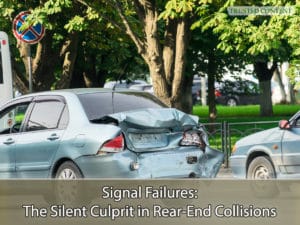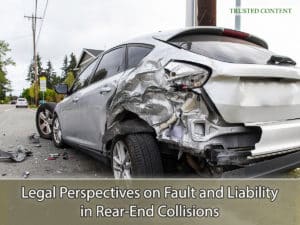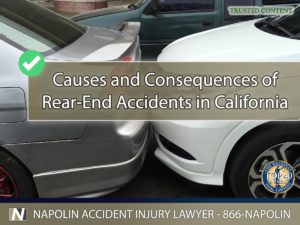Causes and Consequences of Rear-End Accidents in Ontario, California
In California, rear-end collisions stand as a leading cause of road accidents, often resulting in significant physical injuries and property damage. These incidents not only disrupt lives but also raise complex legal and insurance issues. Understanding the dynamics behind rear-end collisions is essential for drivers to mitigate risks and for victims to navigate the aftermath. This article delves into the primary causes of such accidents in California, the legal implications surrounding them, and the importance of securing expert legal assistance in the wake of an accident.

Signal Failures- The Silent Culprit in Rear-End Collisions
Signal Failures: The Silent Culprit in Rear-End Collisions
The Critical Role of Vehicle Maintenance
Regular vehicle maintenance is a fundamental responsibility of every driver, crucial for ensuring safety on the road. Neglecting basic upkeep, especially the functionality of brake lights and turn signals, can lead to catastrophic rear-end collisions. These components serve as vital communication tools, informing other drivers of a vehicle’s intentions. When they fail, the risk of misunderstanding increases, often resulting in accidents.
Preventive Measures and Legal Obligations
California law mandates that all vehicles on the road must have fully operational lights. This legal requirement underscores the importance of regular vehicle inspections and immediate repairs of any lighting issues. Drivers who fail to maintain their vehicle’s lights can be held liable for accidents caused by such negligence. It’s a clear reminder that preventive measures not only protect drivers and passengers but also shield individuals from potential legal consequences.
Merging Mishaps: Navigating Lanes Safely
The Hazards of Unsafe Lane Changes
Unsafe lane changes and abrupt turns are significant factors contributing to rear-end accidents in California. These maneuvers often occur without adequate warning to following drivers, leading to situations where they cannot react in time to prevent a collision. The law requires drivers to signal their intentions clearly and to ensure it is safe to perform such actions before proceeding, aiming to reduce these types of accidents.
Legal Implications of Improper Merging
When investigating a rear-end collision caused by an unsafe lane change or turn, law enforcement and insurance companies examine whether the driver at fault violated traffic laws related to safe lane changes. In California, drivers found making hazardous lane changes can be deemed negligent, impacting the outcome of insurance claims and liability determinations. Victims of such accidents may be entitled to compensation for their injuries and losses, highlighting the importance of understanding and adhering to traffic laws.
Tailgating Troubles: Keeping a Safe Distance
Risks Associated with Following Too Closely
Tailgating, or following another vehicle too closely, significantly increases the likelihood of rear-end collisions. This dangerous practice leaves insufficient stopping distance, reducing the tailgating driver’s ability to react to sudden stops or changes in traffic flow. California’s Vehicle Code explicitly addresses tailgating, establishing legal guidelines for maintaining a safe following distance based on speed and road conditions.
Consequences of Tailgating in California
Drivers who engage in tailgating can be cited for aggressive driving and may be held liable for any accidents that result from this behavior. In the context of rear-end collisions, the tailgating driver is often presumed to be at fault, given their failure to maintain a safe distance. However, each accident is unique, and liability is determined based on the specific circumstances of the crash. Victims of tailgating-induced rear-end collisions should seek legal advice to understand their rights and potential compensation.

Legal Perspectives on Fault and Liability in Rear-End Collisions
Legal Perspectives on Fault and Liability in Rear-End Collisions
Determining fault in rear-end collisions involves a nuanced analysis of the accident circumstances, driver actions, and adherence to California traffic laws. Liability in these cases can be complex, as it may not always rest solely with the rear driver. Factors such as sudden lane changes, signal failures, and road conditions are considered in establishing fault. California operates under a comparative negligence system, meaning that compensation can be adjusted based on the degree of fault of each party involved.
Protecting Your Rights After a Rear-End Collision
If you find yourself the victim of a rear-end collision, it is crucial to take immediate steps to protect your rights. Document the scene, seek medical attention, and report the accident to the authorities and your insurance company. Consulting with a legal professional experienced in California auto accident law can provide invaluable guidance through the claims process, helping to ensure that you receive fair compensation for your injuries, damages, and any long-term impacts of the accident.

Causes and Consequences of Rear-End Accidents in Ontario, California
Causes and Consequences of Rear-End Accidents in Ontario, California
Rear-end collisions, while common, have serious repercussions for those involved. Understanding the causes and legal landscape is crucial for prevention and effective response. If you or a loved one has been involved in a rear-end collision in California, reaching out for legal assistance is a critical step. Contact Napolin Accident Injury Lawyer at (909) 962-8415 for a free consultation. Our team offers extensive litigation experience and a commitment to advocating for the rights of injury victims, ensuring you receive the support and compensation you deserve.
